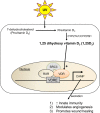Role of micronutrients in skin health and function
- PMID: 25995818
- PMCID: PMC4428712
- DOI: 10.4062/biomolther.2015.003
Role of micronutrients in skin health and function
Abstract
Skin is the first line of defense for protecting our bodies against external perturbations, including ultraviolet (UV) irradiation, mechanical/chemical stress, and bacterial infection. Nutrition is one of many factors required for the maintenance of overall skin health. An impaired nutritional status alters the structural integrity and biological function of skin, resulting in an abnormal skin barrier. In particular, the importance of micronutrients (such as certain vitamins and minerals) for skin health has been highlighted in cell culture, animal, and clinical studies. These micronutrients are employed not only as active compounds in therapeutic agents for treating certain skin diseases, but also as ingredients in cosmetic products. Here, the author describes the barrier function of the skin and the general nutritional requirements for skin health. The goal of this review is to discuss the potential roles and current knowledge of selected micronutrients in skin health and function.
Keywords: Cosmetic ingredient; Micronutrient; Skin disease; Skin function; Therapeutic agent.
Figures





References
-
- Abramovits W. Calcitriol 3 microg/g ointment: an effective and safe addition to the armamentarium in topical psoriasis therapy. J Drugs Dermatol. 2009;8:s17–22. - PubMed
-
- Barresi C, Stremnitzer C, Mlitz V, Kezic S, Kammeyer A, Ghannadan M, Posa-Markaryan K, Selden C, Tschachler E, Eckhart L. Increased sensitivity of histidinemic mice to UVB radiation suggests a crucial role of endogenous urocanic acid in photoprotection. J Invest Dermatol. 2011;131:188–194. doi: 10.1038/jid.2010.231. - DOI - PubMed
Publication types
LinkOut - more resources
Full Text Sources
Other Literature Sources

